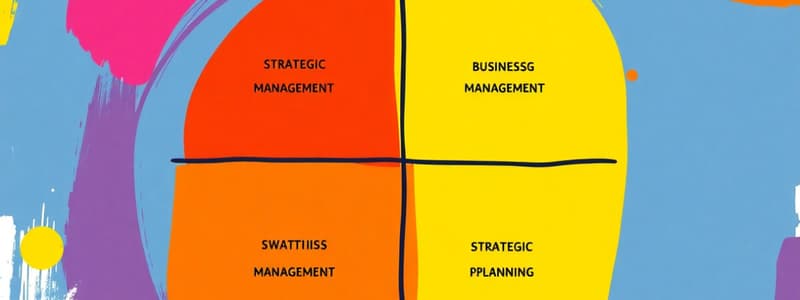Podcast
Questions and Answers
What is the primary focus of Selection in the recruitment process?
What is the primary focus of Selection in the recruitment process?
- Looking at CVs
- Conducting interviews and selection tests (correct)
- Rewarding employees for their performance
- Recruiting employees from other companies
Which of the following is NOT a component of Pay and Benefits?
Which of the following is NOT a component of Pay and Benefits?
- Challenges and responsibilities
- Intrinsic motivation (correct)
- Extrinsic rewards
- Job security
Which leadership theory suggests that certain traits predispose individuals to be leaders?
Which leadership theory suggests that certain traits predispose individuals to be leaders?
- Trait Theory (correct)
- Contingency Theory
- Behavioural Theory
- Charismatic Theory
What is the focus of Alderfer's ERG theory in motivation?
What is the focus of Alderfer's ERG theory in motivation?
What distinguishes charismatic leaders from their non-charismatic counterparts according to leadership theories?
What distinguishes charismatic leaders from their non-charismatic counterparts according to leadership theories?
What is the primary purpose of the operational planning process?
What is the primary purpose of the operational planning process?
Which competitive strategy identifies organizations that are reactive to market changes?
Which competitive strategy identifies organizations that are reactive to market changes?
Which decision-making type typically involves lower levels of management and follows established rules?
Which decision-making type typically involves lower levels of management and follows established rules?
What is the focus of the Boston Consulting Group Matrix?
What is the focus of the Boston Consulting Group Matrix?
In the Managing by Objectives (MBO) approach, who primarily sets the goals?
In the Managing by Objectives (MBO) approach, who primarily sets the goals?
Which element is NOT part of the decision-making process?
Which element is NOT part of the decision-making process?
What is a characteristic of the 'Bounded Rationality' approach to decision-making?
What is a characteristic of the 'Bounded Rationality' approach to decision-making?
What does a mission statement typically outline for a business?
What does a mission statement typically outline for a business?
Which source of power is based on a person's position within an organization?
Which source of power is based on a person's position within an organization?
What psychological phenomenon leads individuals to ignore evidence that contradicts their beliefs?
What psychological phenomenon leads individuals to ignore evidence that contradicts their beliefs?
In an organization, which type of departmentalisation groups employees based on specific functions like marketing or production?
In an organization, which type of departmentalisation groups employees based on specific functions like marketing or production?
What is a primary characteristic of a machine bureaucracy?
What is a primary characteristic of a machine bureaucracy?
What does 'demand analysis' refer to in the human resource planning process?
What does 'demand analysis' refer to in the human resource planning process?
Which structure in Mintzberg's framework is often associated with start-up companies?
Which structure in Mintzberg's framework is often associated with start-up companies?
What phase follows the supply analysis in the human resource planning process?
What phase follows the supply analysis in the human resource planning process?
What characterizes the adhocracy structure in an organization?
What characterizes the adhocracy structure in an organization?
Flashcards
Legitimate Power
Legitimate Power
Power derived from a person's position or role in an organization.
Escalation of Commitment
Escalation of Commitment
A tendency to continue investing in failing projects even when there's clear evidence the project is failing.
Functional Departmentalisation
Functional Departmentalisation
Organisational structure grouping employees based on their similar skills or specialisations (e.g., marketing, finance).
Confirmation Bias
Confirmation Bias
Signup and view all the flashcards
Demand Analysis (HR)
Demand Analysis (HR)
Signup and view all the flashcards
Supply Analysis (HR)
Supply Analysis (HR)
Signup and view all the flashcards
Sunk Costs
Sunk Costs
Signup and view all the flashcards
Simple Structure (Mintzberg)
Simple Structure (Mintzberg)
Signup and view all the flashcards
Strategic Plan
Strategic Plan
Signup and view all the flashcards
Tactical Plan
Tactical Plan
Signup and view all the flashcards
Operational Plan
Operational Plan
Signup and view all the flashcards
MBO (Management by Objectives)
MBO (Management by Objectives)
Signup and view all the flashcards
SWOT Analysis
SWOT Analysis
Signup and view all the flashcards
Programmed Decision
Programmed Decision
Signup and view all the flashcards
Non-Programmed Decision
Non-Programmed Decision
Signup and view all the flashcards
Bounded Rationality
Bounded Rationality
Signup and view all the flashcards
Human Resource Planning
Human Resource Planning
Signup and view all the flashcards
Recruitment
Recruitment
Signup and view all the flashcards
Selection
Selection
Signup and view all the flashcards
Maslow's Hierarchy of Needs - Content Theory
Maslow's Hierarchy of Needs - Content Theory
Signup and view all the flashcards
Leadership - Trait Theory
Leadership - Trait Theory
Signup and view all the flashcards
Study Notes
Management
- Management is the process of using resources (human, financial, knowledge, physical) to achieve organizational goals.
Planning
- Strategic Plan: Long-term (5 years) plan.
- Tactical Plan: Short-term plans derived from the strategic plan.
- Operational Plan: Daily running of the business.
- Mission Statement: Outlines the organization's goals.
Managing by Objectives (MBO)
- Managers set performance standards for subordinates.
- Subordinates set their own goals based on standards.
- Goals and standards are linked with a timeframe.
- Performance reviews and feedback are needed.
SWOT Analysis
- Analysis of Strengths, Weaknesses, Opportunities, and Threats for a business.
Miles and Snow Typology
- Prospector: Seeking new opportunities and markets.
- Defender: Maintaining existing market share and customer satisfaction.
- Analyzer: Combines prospector and defender strategies.
- Reactor: Reacting to competitors' actions without a clear strategy.
Boston Consulting Group Matrix (BCG Matrix)
- Evaluates product portfolio based on market growth rate and market share.
Decision Making
- Programmed Decisions: Everyday decisions based on rules and procedures.
- Non-programmed Decisions: Decisions requiring judgment and creativity, often made at higher levels.
- Decision-Making Process:
- Problem identification and diagnosis
- Identifying alternatives
- Evaluating alternatives
- Choosing an alternative
- Implementing the decision
Approaches to Decision Making
- Rational Model: Making rational decisions.
- Bounded Rationality: Recognizing limitations and using intuition.
- Political Model: Considering power sources in the organization.
- Escalation of Commitment: Continuing a failing project due to sunk costs and confirmation bias.
Organizational Design
- Structural Configuration vs Structural Operation
- Division of Labor: How tasks are divided
- Span of Control: Number of subordinates a manager supervises
- Hierarchy Levels: Number of management layers
- Departmentalisation
- Functional: Grouping by functions (marketing, production)
- Geographical: Grouping by location
- Product: Grouping by product lines
- Mixed: Combination of the above
- Mitzberg Framework:
- Simple Structure: Early-stage businesses, few rules, informal
- Machine Bureaucracy: Many rules, formal structure, hierarchy
- Professional Bureaucracy: Highly skilled employees, less emphasis on rules, hierarchies
- Adhocracy: Flexible structure, adaptable to change
Human Resource
- Human Resource Planning: Forecasting need for HR, and recruitment, selection, training, performance appraisal.
- Recruitment: Attracting candidates
- Selection: Evaluating candidates
- Pay and Benefits: Compensation for employees
- Performance Appraisal: Assessing employee performance
- Training and Development: Improving employee skills.
Importance of Leadership
- Leadership is defined as motivating others to reach common goals.
Theories of Leadership
- Trait Theory: Leaders are born not made
- Behavioral Theory: Leaders have observable behaviors
- Contingency Theory: Effective leadership is dependent on the situation
- Charismatic Leadership: Inspiring and influencing others
Motivation
- Content Theories: Focus on factors that motivate people (Maslow, Alderfer, McClelland, Herzberg).
- Process Theories: Explain how motivation takes place (Vroom's Expectancy Theory, Adams Equity Theory).
Control Process
- Setting Standards: Establishing performance targets.
- Measuring and Comparing Performance: Monitoring actual performance against standards.
- Taking Corrective Action: Addressing performance gaps.
- Types of Control:
- Feedforward Control: Preventing issues before they happen
- Concurrent Control: Managing actions while they are occurring
- Feedback Control: Monitoring results for improvement
Financial Controls
- Budgetary Control: Using budgets to monitor spending.
- Break-even Analysis: Determining the point where revenue equals costs.
Non-Financial Controls
- Gantt Charts
- Total Quality Management (TQM)
Studying That Suits You
Use AI to generate personalized quizzes and flashcards to suit your learning preferences.



